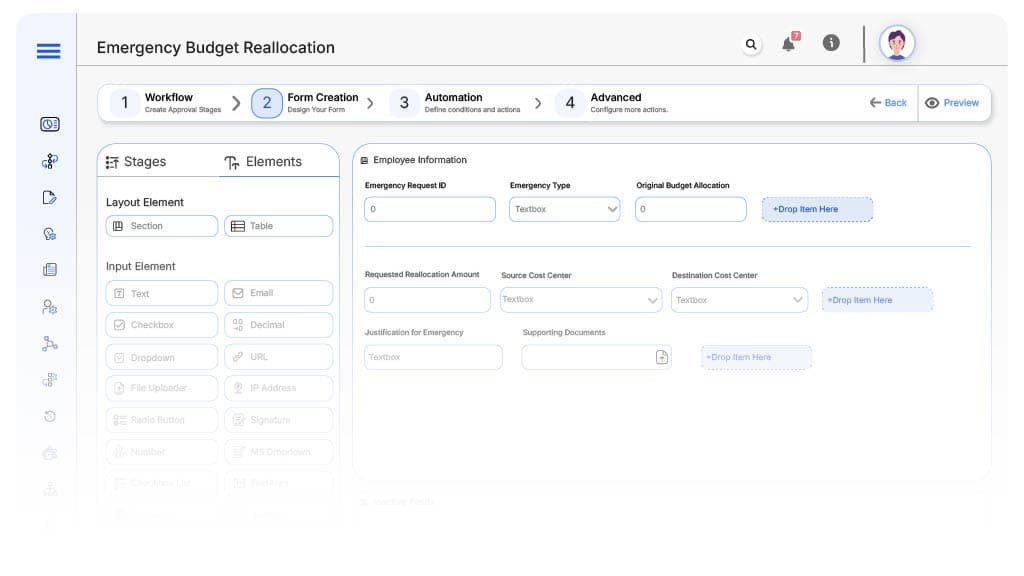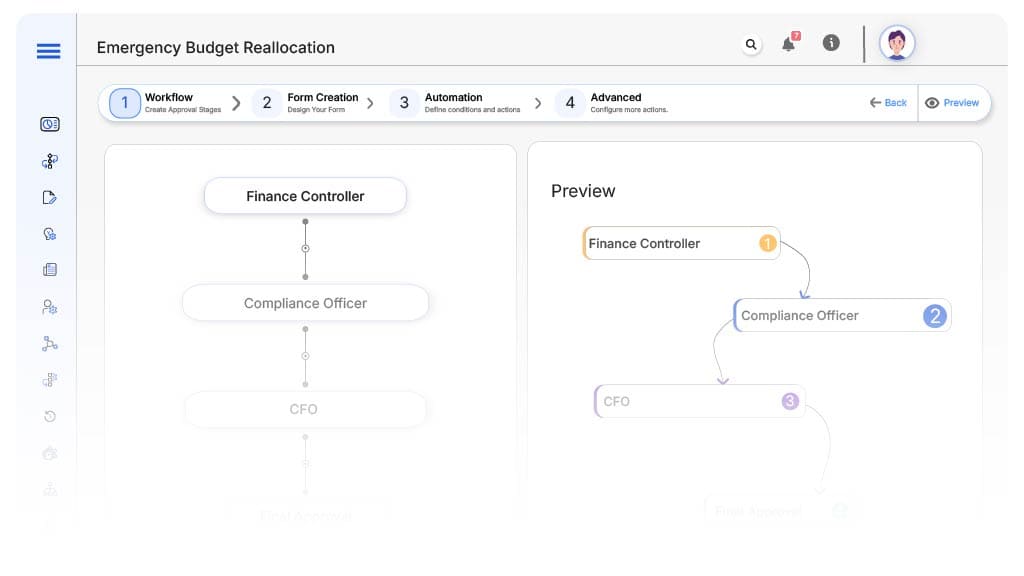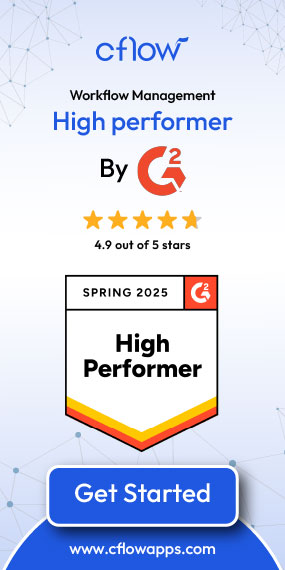- Cflow
- Emergency Budget Reallocation Automation
Emergency Budget Reallocation Automation

Clow Team

Emergency budget reallocations are crucial for organizations to address unforeseen expenses that cannot wait for annual budget cycles. Whether it’s a regulatory fine, system breakdown, or project overrun, reallocating funds quickly can prevent major disruptions. Yet, most organizations still rely on manual processes riddled with delays, approvals lost in email chains, and missing documentation.
Without automation, department heads, finance controllers, compliance teams, and CFOs face significant friction in justifying needs, validating budgets, routing approvals, and maintaining full audit readiness. This guide walks you through exactly how Cflow automates the Emergency Budget Reallocation process from request initiation to executive sign-off.
What Is Emergency Budget Reallocation Process?
The Emergency Budget Reallocation Process governs how organizations reassign funds across cost centers in response to urgent requirements like compliance fines, unplanned outages, or critical operational demands.
Think of it as internal financial firefighting where strategic resource shifts must happen swiftly, accurately, and transparently under pressure.
Research shows that automating this process can reduce financial risk by 40% and improve emergency response efficiency by 60%.
Why Emergency Budget Reallocation Matters for Organizations
Risk Control
Regulatory Compliance
Cost Efficiency
Audit Readiness
Executive Visibility
Key Benefits of Automating Emergency Budget Reallocation with Cflow
- Centralized Request Portal: Cflow enables department heads or business units to initiate emergency reallocation requests through a structured portal. Supporting documents like justification memos, cost center reports, and approvals are uploaded in one place. This streamlines submissions and reduces email trails.
- Dynamic Routing Based on Emergency Type & Amount: Routing logic in Cflow adapts based on the nature of emergency (e.g., system failure, legal compliance, project overrun), source department, and requested amount. Large reallocations are automatically escalated to CFO-level approval.
- Multi-Level Review Workflows: Requests are routed to finance controllers, compliance teams, and executive leadership for approvals. Task ownership and deadlines are auto-assigned, enabling faster cycle times without compromising due diligence.
- Real-Time Notifications & Escalations: Cflow ensures that every pending review or overdue action is flagged via real-time alerts. Escalation logic helps avoid bottlenecks during critical timelines, improving organizational responsiveness.
- Policy Compliance Enforcement: Internal budget policies, reallocation thresholds, and board-defined caps are configured into Cflow. Requests breaching these thresholds trigger alternate flows or auto-rejections, ensuring zero non-compliant reallocations.
- Full Audit Trail & Decision History: Every approval, comment, justification, and allocation confirmation is time-stamped and archived. This ensures that auditors and regulators can trace each reallocation decision with clarity.
- Mobile Accessibility: Senior finance leaders and compliance officers can review, approve, or comment on reallocation requests directly from their mobile devices. This helps ensure that urgent funding needs aren’t stalled due to availability.
Get the best value for money with Cflow
User Roles & Permissions
Requestor (Initiator)
- Responsibilities: Submit emergency reallocation request with justification and required documents.
- Cflow Permission Level: Submit Form.
- Mapping: “Department Head”
Finance Controller
- Responsibilities: Review fund availability, cost center impact, and financial feasibility.
- Cflow Permission Level: Approve/Reject.
- Mapping: “Finance Team”
Compliance Officer
- Responsibilities: Validate compliance, audit coverage, and regulatory impact of the reallocation.
- Cflow Permission Level: Approve/Reject.
- Mapping: “Compliance Group”
CFO / Leadership
- Responsibilities: Provide final sign-off for large or policy-sensitive reallocations.
Cflow Permission Level: Approve/Reject. - Mapping: “Executive Board”
Discover why teams choose Cflow
Form Design & Field Definitions

Field Label: Emergency Request ID
- Type: Autonumber
- Auto-Populate: Generated on submission.
Field Label: Emergency Type
- Type: Dropdown (Regulatory Fine, Equipment Breakdown, Compliance Mandate, Project Overrun)
- Logic/Rules: Drives Routing
Field Label: Original Budget Allocation
- Type: Numeric Field
- Logic/Rules: Read-only for context
Field Label: Requested Reallocation Amount
- Type: Numeric Field
- Logic/Rules: Mandatory for finance
Field Label: Source Cost Center
- Type: Dropdown
- Logic/Rules: Defines available funds
Field Label: Destination Cost Center
- Type: Dropdown
- Logic/Rules: Mandatory
Field Label: Justification for Emergency
- Type: Text Area
- Logic/Rules: Required
Field Label: Supporting Documents
- Type: File Upload
- Logic/Rules: Mandatory
Field Label: Finance Review Notes
- Type: Text Area
- Logic/Rules: Required
Field Label: Compliance Remarks
- Type: Text Area
- Logic/Rules: Required
Field Label: CFO Comments
- Type: Text Area
- Logic/Rules: Required
Field Label: Reallocation Confirmation
- Type: Checkbox
- Logic/Rules: Confirms fund transfer approval
Transform your Workflow with AI fusion
Approval Flow & Routing Logic

Submission → Finance Controller
- Status Name: Pending Finance Review
- Notification Template: “Hi Finance Team, new emergency budget request submitted for evaluation.”
- On Approve: Moves to Compliance Officer
- On Reject: Returns to Requestor
- Escalation: Reminder after 1 day
Finance → Compliance Officer
- Status Name: Pending Compliance Review
- Notification Template: “Hi Compliance, review the emergency reallocation for regulatory implications.”
- On Approve: Moves to CFO
- On Reject: Returns to Finance Controller
- Escalation: Reminder after 1 day
Compliance → CFO
- Status Name: Pending Executive Sign-Off
- Notification Template: “Hi CFO, emergency reallocation request requires final approval.”
- On Approve: Moves to Approved
- On Reject: Returns to Compliance Officer
- Escalation: Reminder after 1 day
Final → Approved
- Status Name: Emergency Reallocation Approved
- Notification Template: “Request approved. Budget updated and reallocation processed.”
Transform your AI-powered approvals
Implementation Steps in Cflow
Create a new workflow
Design the form
Set up User Roles/Groups
Build process flow
Configure notifications
Set conditional logic
Save and publish workflow
Test
Adjust logic
Go live
Example Journey: Regulatory Fine Reallocation
FAQ's
Unleash the full potential of your AI-powered Workflow

